Business Economics Assignment 1 - Module Analysis Spring 2020
VerifiedAdded on 2022/08/22
|19
|5674
|14
Homework Assignment
AI Summary
This assignment delves into the realm of business economics, providing a comprehensive analysis of market structures, specifically focusing on the oligopolistic nature of the banking industry. It examines JPMorgan Chase & Co. as a case study, exploring its strategies within the competitive landscape and its expansion plans, including a joint venture in China. The assignment further analyzes the international product life cycle, using JPMorgan's CDO product as an example of a product experiencing decline. It also contrasts cost-oriented and market-oriented pricing strategies, concluding that JPMorgan Chase & Co. operates primarily as a market-based organization. The analysis emphasizes the company's focus on competition, customer centricity, and the constant need to adapt to the actions of its competitors in the dynamic financial market.
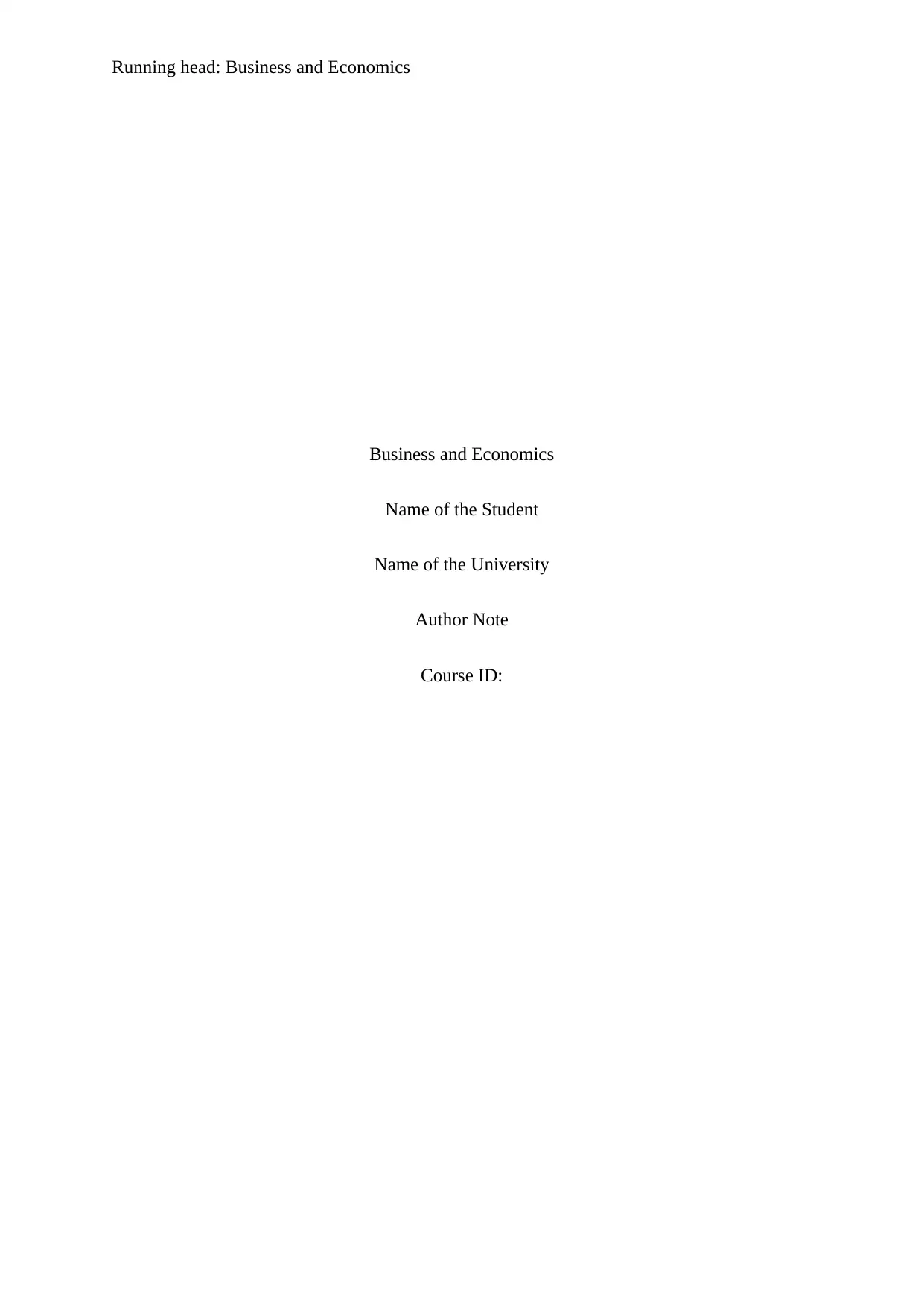
Running head: Business and Economics
Business and Economics
Name of the Student
Name of the University
Author Note
Course ID:
Business and Economics
Name of the Student
Name of the University
Author Note
Course ID:
Paraphrase This Document
Need a fresh take? Get an instant paraphrase of this document with our AI Paraphraser
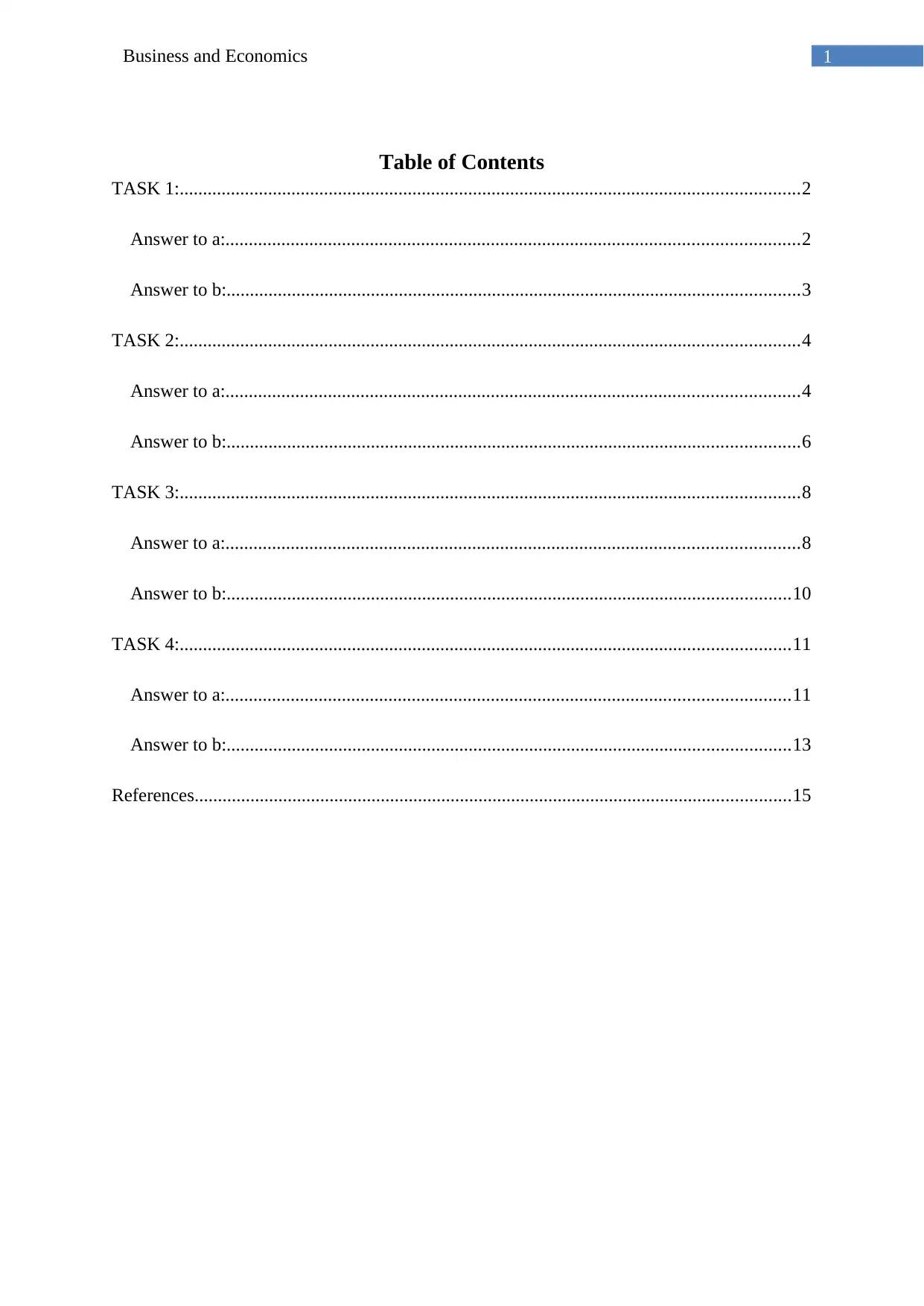
1Business and Economics
Table of Contents
TASK 1:.....................................................................................................................................2
Answer to a:...........................................................................................................................2
Answer to b:...........................................................................................................................3
TASK 2:.....................................................................................................................................4
Answer to a:...........................................................................................................................4
Answer to b:...........................................................................................................................6
TASK 3:.....................................................................................................................................8
Answer to a:...........................................................................................................................8
Answer to b:.........................................................................................................................10
TASK 4:...................................................................................................................................11
Answer to a:.........................................................................................................................11
Answer to b:.........................................................................................................................13
References................................................................................................................................15
Table of Contents
TASK 1:.....................................................................................................................................2
Answer to a:...........................................................................................................................2
Answer to b:...........................................................................................................................3
TASK 2:.....................................................................................................................................4
Answer to a:...........................................................................................................................4
Answer to b:...........................................................................................................................6
TASK 3:.....................................................................................................................................8
Answer to a:...........................................................................................................................8
Answer to b:.........................................................................................................................10
TASK 4:...................................................................................................................................11
Answer to a:.........................................................................................................................11
Answer to b:.........................................................................................................................13
References................................................................................................................................15
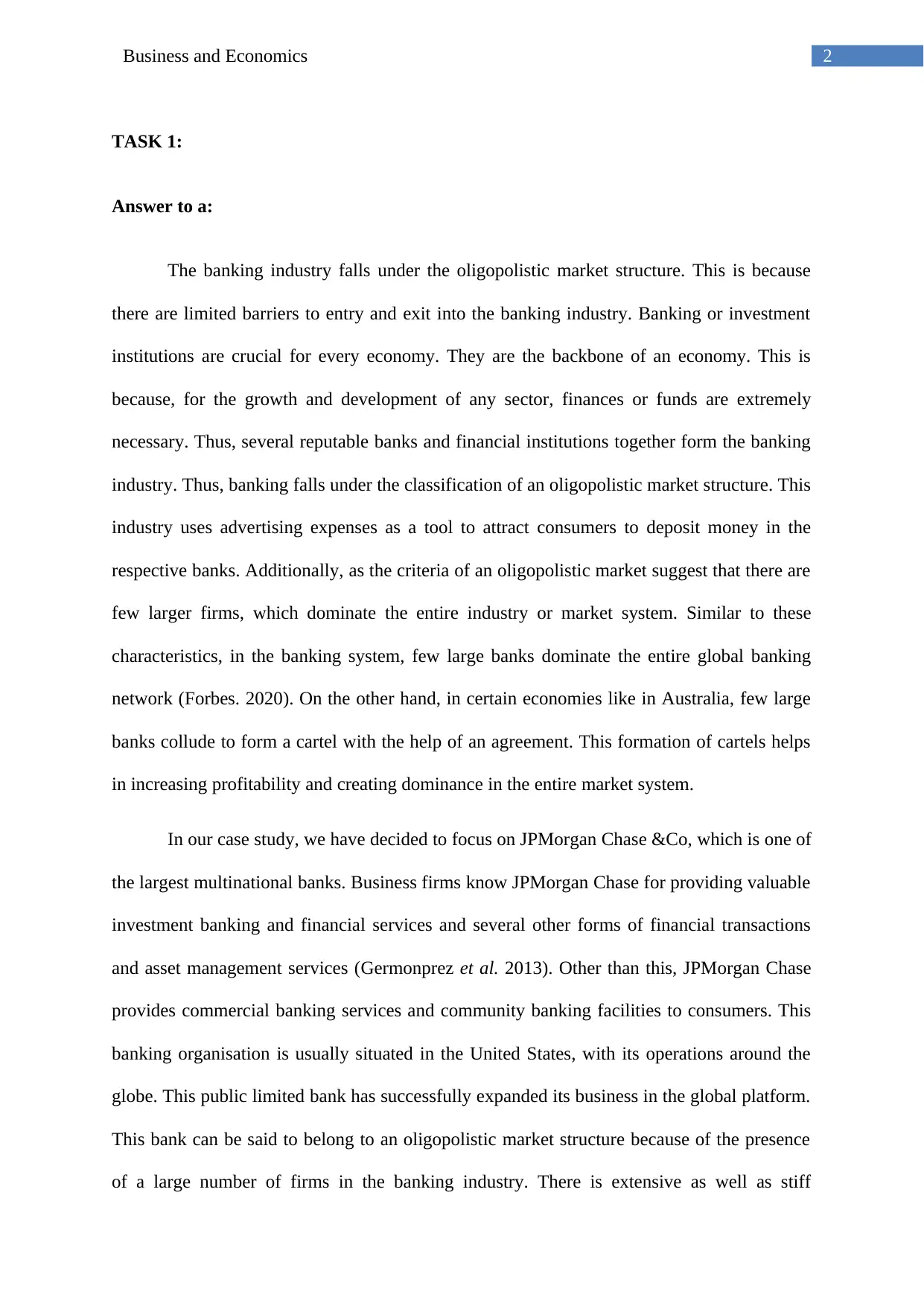
2Business and Economics
TASK 1:
Answer to a:
The banking industry falls under the oligopolistic market structure. This is because
there are limited barriers to entry and exit into the banking industry. Banking or investment
institutions are crucial for every economy. They are the backbone of an economy. This is
because, for the growth and development of any sector, finances or funds are extremely
necessary. Thus, several reputable banks and financial institutions together form the banking
industry. Thus, banking falls under the classification of an oligopolistic market structure. This
industry uses advertising expenses as a tool to attract consumers to deposit money in the
respective banks. Additionally, as the criteria of an oligopolistic market suggest that there are
few larger firms, which dominate the entire industry or market system. Similar to these
characteristics, in the banking system, few large banks dominate the entire global banking
network (Forbes. 2020). On the other hand, in certain economies like in Australia, few large
banks collude to form a cartel with the help of an agreement. This formation of cartels helps
in increasing profitability and creating dominance in the entire market system.
In our case study, we have decided to focus on JPMorgan Chase &Co, which is one of
the largest multinational banks. Business firms know JPMorgan Chase for providing valuable
investment banking and financial services and several other forms of financial transactions
and asset management services (Germonprez et al. 2013). Other than this, JPMorgan Chase
provides commercial banking services and community banking facilities to consumers. This
banking organisation is usually situated in the United States, with its operations around the
globe. This public limited bank has successfully expanded its business in the global platform.
This bank can be said to belong to an oligopolistic market structure because of the presence
of a large number of firms in the banking industry. There is extensive as well as stiff
TASK 1:
Answer to a:
The banking industry falls under the oligopolistic market structure. This is because
there are limited barriers to entry and exit into the banking industry. Banking or investment
institutions are crucial for every economy. They are the backbone of an economy. This is
because, for the growth and development of any sector, finances or funds are extremely
necessary. Thus, several reputable banks and financial institutions together form the banking
industry. Thus, banking falls under the classification of an oligopolistic market structure. This
industry uses advertising expenses as a tool to attract consumers to deposit money in the
respective banks. Additionally, as the criteria of an oligopolistic market suggest that there are
few larger firms, which dominate the entire industry or market system. Similar to these
characteristics, in the banking system, few large banks dominate the entire global banking
network (Forbes. 2020). On the other hand, in certain economies like in Australia, few large
banks collude to form a cartel with the help of an agreement. This formation of cartels helps
in increasing profitability and creating dominance in the entire market system.
In our case study, we have decided to focus on JPMorgan Chase &Co, which is one of
the largest multinational banks. Business firms know JPMorgan Chase for providing valuable
investment banking and financial services and several other forms of financial transactions
and asset management services (Germonprez et al. 2013). Other than this, JPMorgan Chase
provides commercial banking services and community banking facilities to consumers. This
banking organisation is usually situated in the United States, with its operations around the
globe. This public limited bank has successfully expanded its business in the global platform.
This bank can be said to belong to an oligopolistic market structure because of the presence
of a large number of firms in the banking industry. There is extensive as well as stiff
⊘ This is a preview!⊘
Do you want full access?
Subscribe today to unlock all pages.

Trusted by 1+ million students worldwide
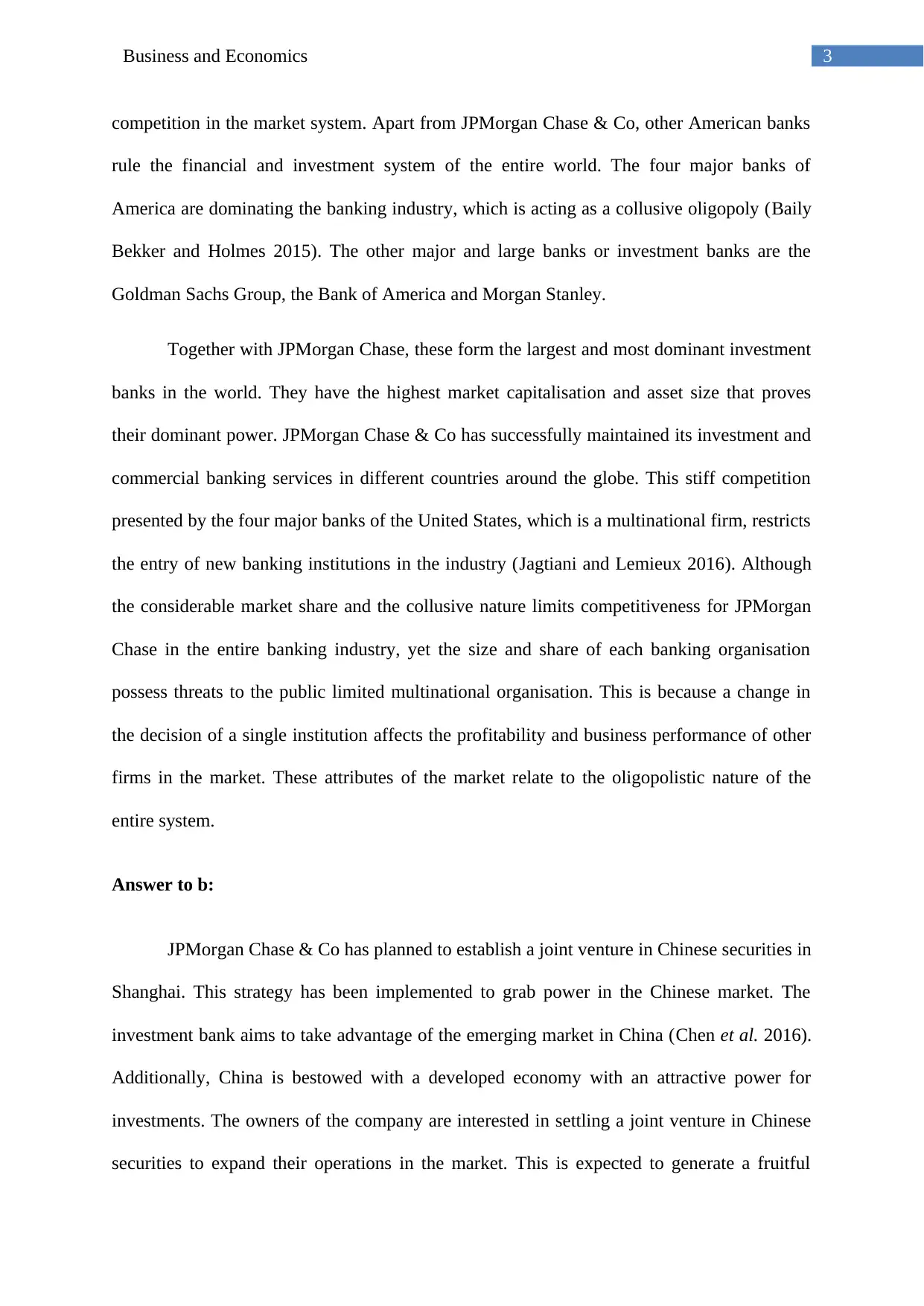
3Business and Economics
competition in the market system. Apart from JPMorgan Chase & Co, other American banks
rule the financial and investment system of the entire world. The four major banks of
America are dominating the banking industry, which is acting as a collusive oligopoly (Baily
Bekker and Holmes 2015). The other major and large banks or investment banks are the
Goldman Sachs Group, the Bank of America and Morgan Stanley.
Together with JPMorgan Chase, these form the largest and most dominant investment
banks in the world. They have the highest market capitalisation and asset size that proves
their dominant power. JPMorgan Chase & Co has successfully maintained its investment and
commercial banking services in different countries around the globe. This stiff competition
presented by the four major banks of the United States, which is a multinational firm, restricts
the entry of new banking institutions in the industry (Jagtiani and Lemieux 2016). Although
the considerable market share and the collusive nature limits competitiveness for JPMorgan
Chase in the entire banking industry, yet the size and share of each banking organisation
possess threats to the public limited multinational organisation. This is because a change in
the decision of a single institution affects the profitability and business performance of other
firms in the market. These attributes of the market relate to the oligopolistic nature of the
entire system.
Answer to b:
JPMorgan Chase & Co has planned to establish a joint venture in Chinese securities in
Shanghai. This strategy has been implemented to grab power in the Chinese market. The
investment bank aims to take advantage of the emerging market in China (Chen et al. 2016).
Additionally, China is bestowed with a developed economy with an attractive power for
investments. The owners of the company are interested in settling a joint venture in Chinese
securities to expand their operations in the market. This is expected to generate a fruitful
competition in the market system. Apart from JPMorgan Chase & Co, other American banks
rule the financial and investment system of the entire world. The four major banks of
America are dominating the banking industry, which is acting as a collusive oligopoly (Baily
Bekker and Holmes 2015). The other major and large banks or investment banks are the
Goldman Sachs Group, the Bank of America and Morgan Stanley.
Together with JPMorgan Chase, these form the largest and most dominant investment
banks in the world. They have the highest market capitalisation and asset size that proves
their dominant power. JPMorgan Chase & Co has successfully maintained its investment and
commercial banking services in different countries around the globe. This stiff competition
presented by the four major banks of the United States, which is a multinational firm, restricts
the entry of new banking institutions in the industry (Jagtiani and Lemieux 2016). Although
the considerable market share and the collusive nature limits competitiveness for JPMorgan
Chase in the entire banking industry, yet the size and share of each banking organisation
possess threats to the public limited multinational organisation. This is because a change in
the decision of a single institution affects the profitability and business performance of other
firms in the market. These attributes of the market relate to the oligopolistic nature of the
entire system.
Answer to b:
JPMorgan Chase & Co has planned to establish a joint venture in Chinese securities in
Shanghai. This strategy has been implemented to grab power in the Chinese market. The
investment bank aims to take advantage of the emerging market in China (Chen et al. 2016).
Additionally, China is bestowed with a developed economy with an attractive power for
investments. The owners of the company are interested in settling a joint venture in Chinese
securities to expand their operations in the market. This is expected to generate a fruitful
Paraphrase This Document
Need a fresh take? Get an instant paraphrase of this document with our AI Paraphraser
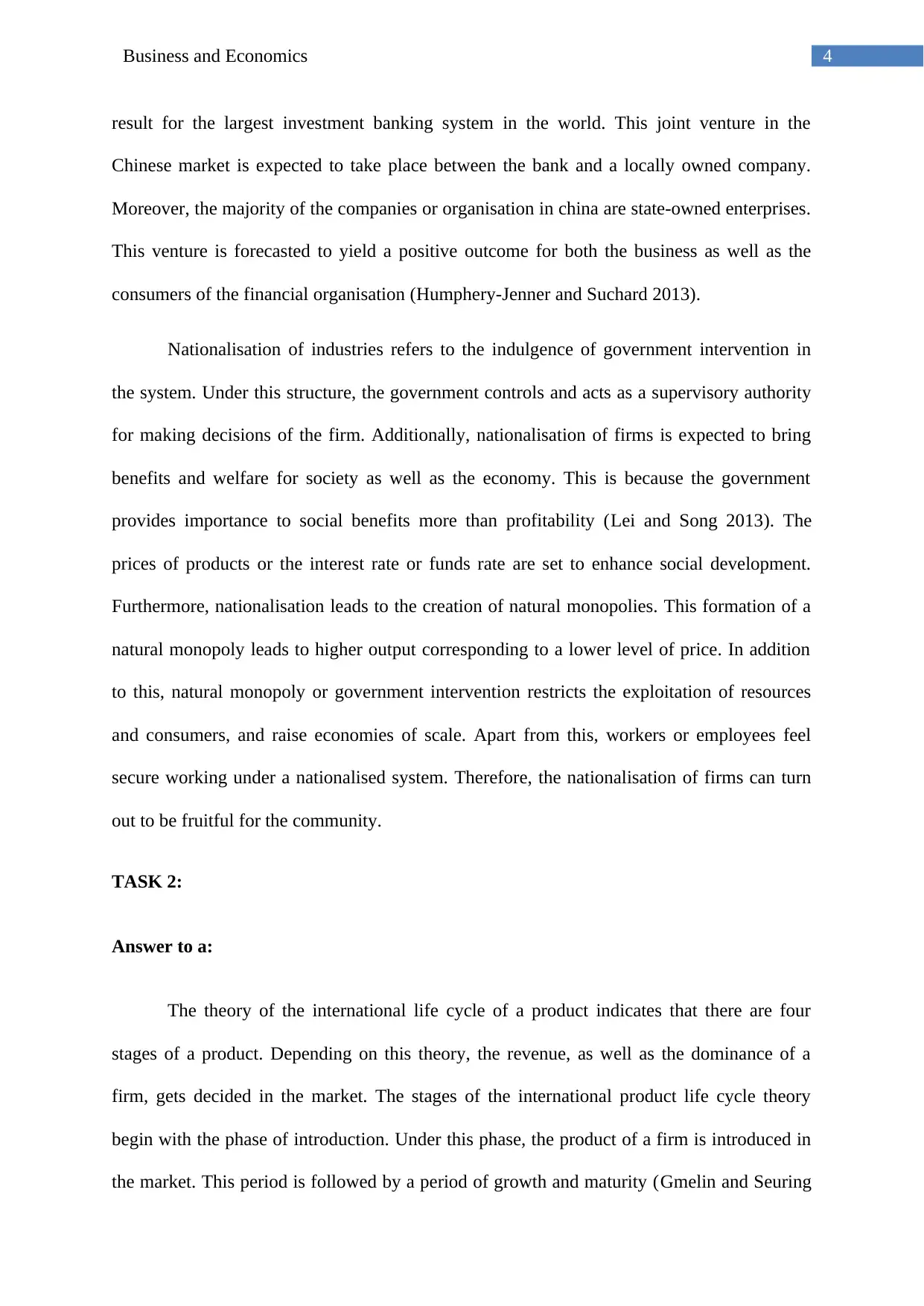
4Business and Economics
result for the largest investment banking system in the world. This joint venture in the
Chinese market is expected to take place between the bank and a locally owned company.
Moreover, the majority of the companies or organisation in china are state-owned enterprises.
This venture is forecasted to yield a positive outcome for both the business as well as the
consumers of the financial organisation (Humphery-Jenner and Suchard 2013).
Nationalisation of industries refers to the indulgence of government intervention in
the system. Under this structure, the government controls and acts as a supervisory authority
for making decisions of the firm. Additionally, nationalisation of firms is expected to bring
benefits and welfare for society as well as the economy. This is because the government
provides importance to social benefits more than profitability (Lei and Song 2013). The
prices of products or the interest rate or funds rate are set to enhance social development.
Furthermore, nationalisation leads to the creation of natural monopolies. This formation of a
natural monopoly leads to higher output corresponding to a lower level of price. In addition
to this, natural monopoly or government intervention restricts the exploitation of resources
and consumers, and raise economies of scale. Apart from this, workers or employees feel
secure working under a nationalised system. Therefore, the nationalisation of firms can turn
out to be fruitful for the community.
TASK 2:
Answer to a:
The theory of the international life cycle of a product indicates that there are four
stages of a product. Depending on this theory, the revenue, as well as the dominance of a
firm, gets decided in the market. The stages of the international product life cycle theory
begin with the phase of introduction. Under this phase, the product of a firm is introduced in
the market. This period is followed by a period of growth and maturity (Gmelin and Seuring
result for the largest investment banking system in the world. This joint venture in the
Chinese market is expected to take place between the bank and a locally owned company.
Moreover, the majority of the companies or organisation in china are state-owned enterprises.
This venture is forecasted to yield a positive outcome for both the business as well as the
consumers of the financial organisation (Humphery-Jenner and Suchard 2013).
Nationalisation of industries refers to the indulgence of government intervention in
the system. Under this structure, the government controls and acts as a supervisory authority
for making decisions of the firm. Additionally, nationalisation of firms is expected to bring
benefits and welfare for society as well as the economy. This is because the government
provides importance to social benefits more than profitability (Lei and Song 2013). The
prices of products or the interest rate or funds rate are set to enhance social development.
Furthermore, nationalisation leads to the creation of natural monopolies. This formation of a
natural monopoly leads to higher output corresponding to a lower level of price. In addition
to this, natural monopoly or government intervention restricts the exploitation of resources
and consumers, and raise economies of scale. Apart from this, workers or employees feel
secure working under a nationalised system. Therefore, the nationalisation of firms can turn
out to be fruitful for the community.
TASK 2:
Answer to a:
The theory of the international life cycle of a product indicates that there are four
stages of a product. Depending on this theory, the revenue, as well as the dominance of a
firm, gets decided in the market. The stages of the international product life cycle theory
begin with the phase of introduction. Under this phase, the product of a firm is introduced in
the market. This period is followed by a period of growth and maturity (Gmelin and Seuring
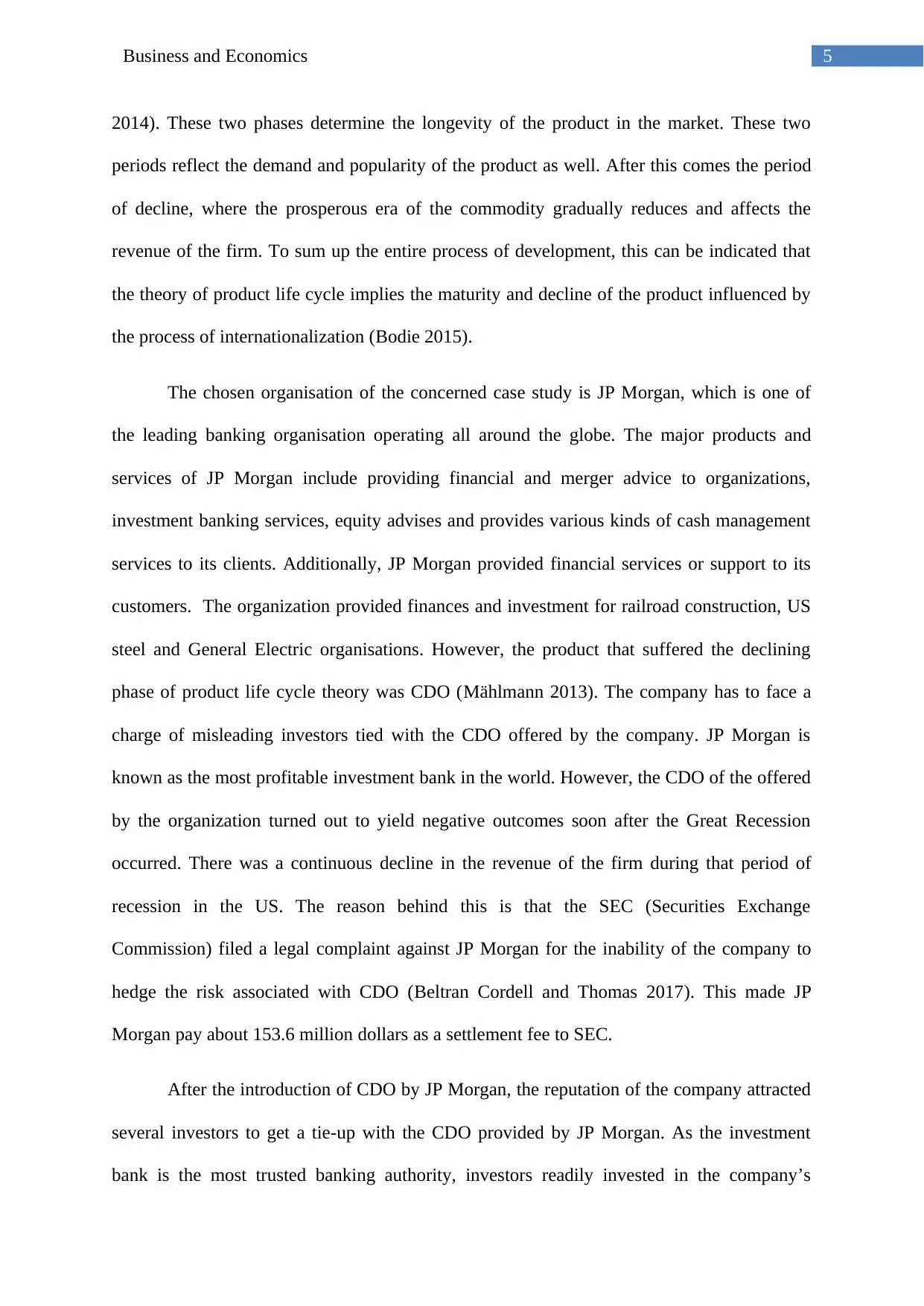
5Business and Economics
2014). These two phases determine the longevity of the product in the market. These two
periods reflect the demand and popularity of the product as well. After this comes the period
of decline, where the prosperous era of the commodity gradually reduces and affects the
revenue of the firm. To sum up the entire process of development, this can be indicated that
the theory of product life cycle implies the maturity and decline of the product influenced by
the process of internationalization (Bodie 2015).
The chosen organisation of the concerned case study is JP Morgan, which is one of
the leading banking organisation operating all around the globe. The major products and
services of JP Morgan include providing financial and merger advice to organizations,
investment banking services, equity advises and provides various kinds of cash management
services to its clients. Additionally, JP Morgan provided financial services or support to its
customers. The organization provided finances and investment for railroad construction, US
steel and General Electric organisations. However, the product that suffered the declining
phase of product life cycle theory was CDO (Mählmann 2013). The company has to face a
charge of misleading investors tied with the CDO offered by the company. JP Morgan is
known as the most profitable investment bank in the world. However, the CDO of the offered
by the organization turned out to yield negative outcomes soon after the Great Recession
occurred. There was a continuous decline in the revenue of the firm during that period of
recession in the US. The reason behind this is that the SEC (Securities Exchange
Commission) filed a legal complaint against JP Morgan for the inability of the company to
hedge the risk associated with CDO (Beltran Cordell and Thomas 2017). This made JP
Morgan pay about 153.6 million dollars as a settlement fee to SEC.
After the introduction of CDO by JP Morgan, the reputation of the company attracted
several investors to get a tie-up with the CDO provided by JP Morgan. As the investment
bank is the most trusted banking authority, investors readily invested in the company’s
2014). These two phases determine the longevity of the product in the market. These two
periods reflect the demand and popularity of the product as well. After this comes the period
of decline, where the prosperous era of the commodity gradually reduces and affects the
revenue of the firm. To sum up the entire process of development, this can be indicated that
the theory of product life cycle implies the maturity and decline of the product influenced by
the process of internationalization (Bodie 2015).
The chosen organisation of the concerned case study is JP Morgan, which is one of
the leading banking organisation operating all around the globe. The major products and
services of JP Morgan include providing financial and merger advice to organizations,
investment banking services, equity advises and provides various kinds of cash management
services to its clients. Additionally, JP Morgan provided financial services or support to its
customers. The organization provided finances and investment for railroad construction, US
steel and General Electric organisations. However, the product that suffered the declining
phase of product life cycle theory was CDO (Mählmann 2013). The company has to face a
charge of misleading investors tied with the CDO offered by the company. JP Morgan is
known as the most profitable investment bank in the world. However, the CDO of the offered
by the organization turned out to yield negative outcomes soon after the Great Recession
occurred. There was a continuous decline in the revenue of the firm during that period of
recession in the US. The reason behind this is that the SEC (Securities Exchange
Commission) filed a legal complaint against JP Morgan for the inability of the company to
hedge the risk associated with CDO (Beltran Cordell and Thomas 2017). This made JP
Morgan pay about 153.6 million dollars as a settlement fee to SEC.
After the introduction of CDO by JP Morgan, the reputation of the company attracted
several investors to get a tie-up with the CDO provided by JP Morgan. As the investment
bank is the most trusted banking authority, investors readily invested in the company’s
⊘ This is a preview!⊘
Do you want full access?
Subscribe today to unlock all pages.

Trusted by 1+ million students worldwide
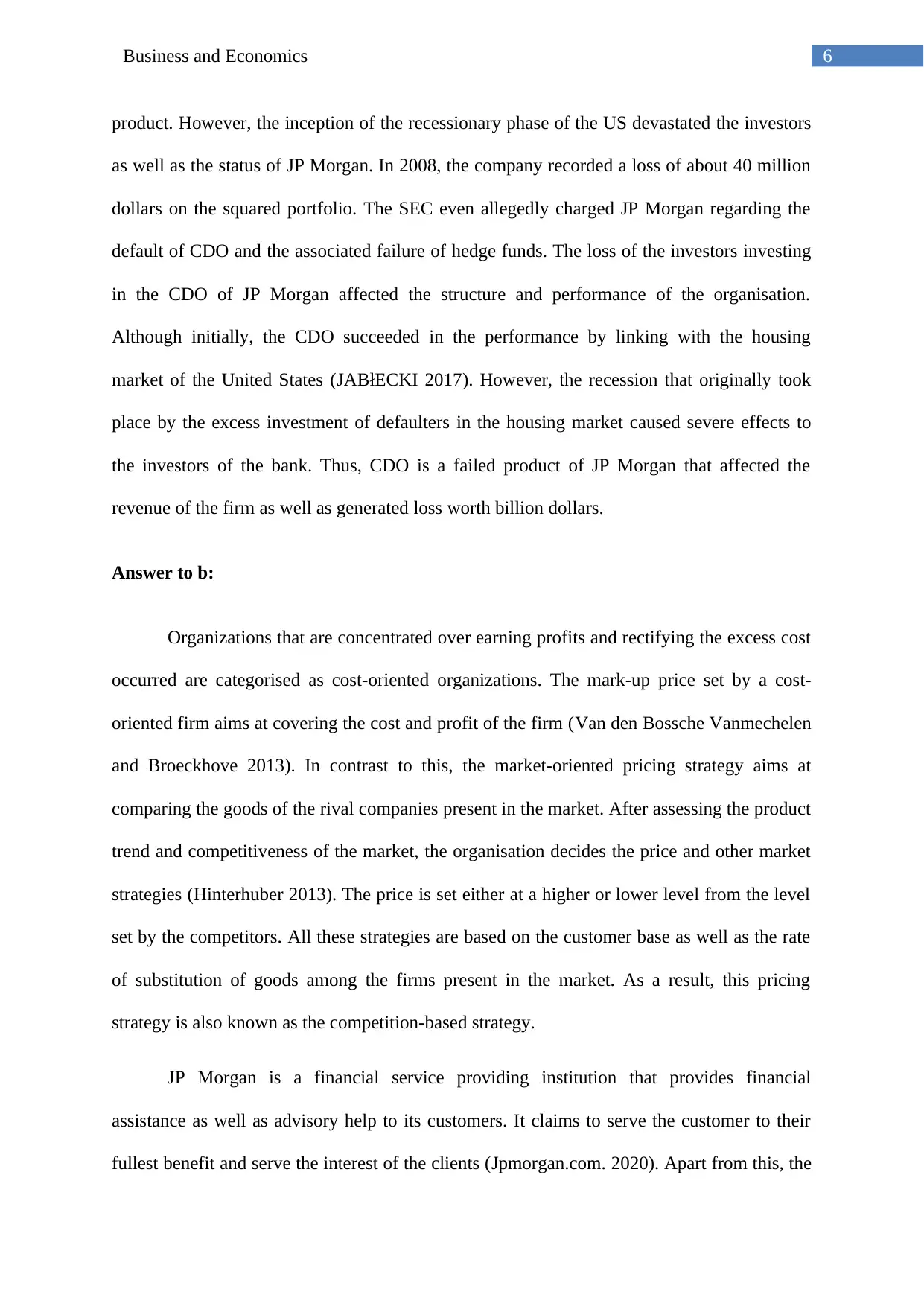
6Business and Economics
product. However, the inception of the recessionary phase of the US devastated the investors
as well as the status of JP Morgan. In 2008, the company recorded a loss of about 40 million
dollars on the squared portfolio. The SEC even allegedly charged JP Morgan regarding the
default of CDO and the associated failure of hedge funds. The loss of the investors investing
in the CDO of JP Morgan affected the structure and performance of the organisation.
Although initially, the CDO succeeded in the performance by linking with the housing
market of the United States (JABłECKI 2017). However, the recession that originally took
place by the excess investment of defaulters in the housing market caused severe effects to
the investors of the bank. Thus, CDO is a failed product of JP Morgan that affected the
revenue of the firm as well as generated loss worth billion dollars.
Answer to b:
Organizations that are concentrated over earning profits and rectifying the excess cost
occurred are categorised as cost-oriented organizations. The mark-up price set by a cost-
oriented firm aims at covering the cost and profit of the firm (Van den Bossche Vanmechelen
and Broeckhove 2013). In contrast to this, the market-oriented pricing strategy aims at
comparing the goods of the rival companies present in the market. After assessing the product
trend and competitiveness of the market, the organisation decides the price and other market
strategies (Hinterhuber 2013). The price is set either at a higher or lower level from the level
set by the competitors. All these strategies are based on the customer base as well as the rate
of substitution of goods among the firms present in the market. As a result, this pricing
strategy is also known as the competition-based strategy.
JP Morgan is a financial service providing institution that provides financial
assistance as well as advisory help to its customers. It claims to serve the customer to their
fullest benefit and serve the interest of the clients (Jpmorgan.com. 2020). Apart from this, the
product. However, the inception of the recessionary phase of the US devastated the investors
as well as the status of JP Morgan. In 2008, the company recorded a loss of about 40 million
dollars on the squared portfolio. The SEC even allegedly charged JP Morgan regarding the
default of CDO and the associated failure of hedge funds. The loss of the investors investing
in the CDO of JP Morgan affected the structure and performance of the organisation.
Although initially, the CDO succeeded in the performance by linking with the housing
market of the United States (JABłECKI 2017). However, the recession that originally took
place by the excess investment of defaulters in the housing market caused severe effects to
the investors of the bank. Thus, CDO is a failed product of JP Morgan that affected the
revenue of the firm as well as generated loss worth billion dollars.
Answer to b:
Organizations that are concentrated over earning profits and rectifying the excess cost
occurred are categorised as cost-oriented organizations. The mark-up price set by a cost-
oriented firm aims at covering the cost and profit of the firm (Van den Bossche Vanmechelen
and Broeckhove 2013). In contrast to this, the market-oriented pricing strategy aims at
comparing the goods of the rival companies present in the market. After assessing the product
trend and competitiveness of the market, the organisation decides the price and other market
strategies (Hinterhuber 2013). The price is set either at a higher or lower level from the level
set by the competitors. All these strategies are based on the customer base as well as the rate
of substitution of goods among the firms present in the market. As a result, this pricing
strategy is also known as the competition-based strategy.
JP Morgan is a financial service providing institution that provides financial
assistance as well as advisory help to its customers. It claims to serve the customer to their
fullest benefit and serve the interest of the clients (Jpmorgan.com. 2020). Apart from this, the
Paraphrase This Document
Need a fresh take? Get an instant paraphrase of this document with our AI Paraphraser
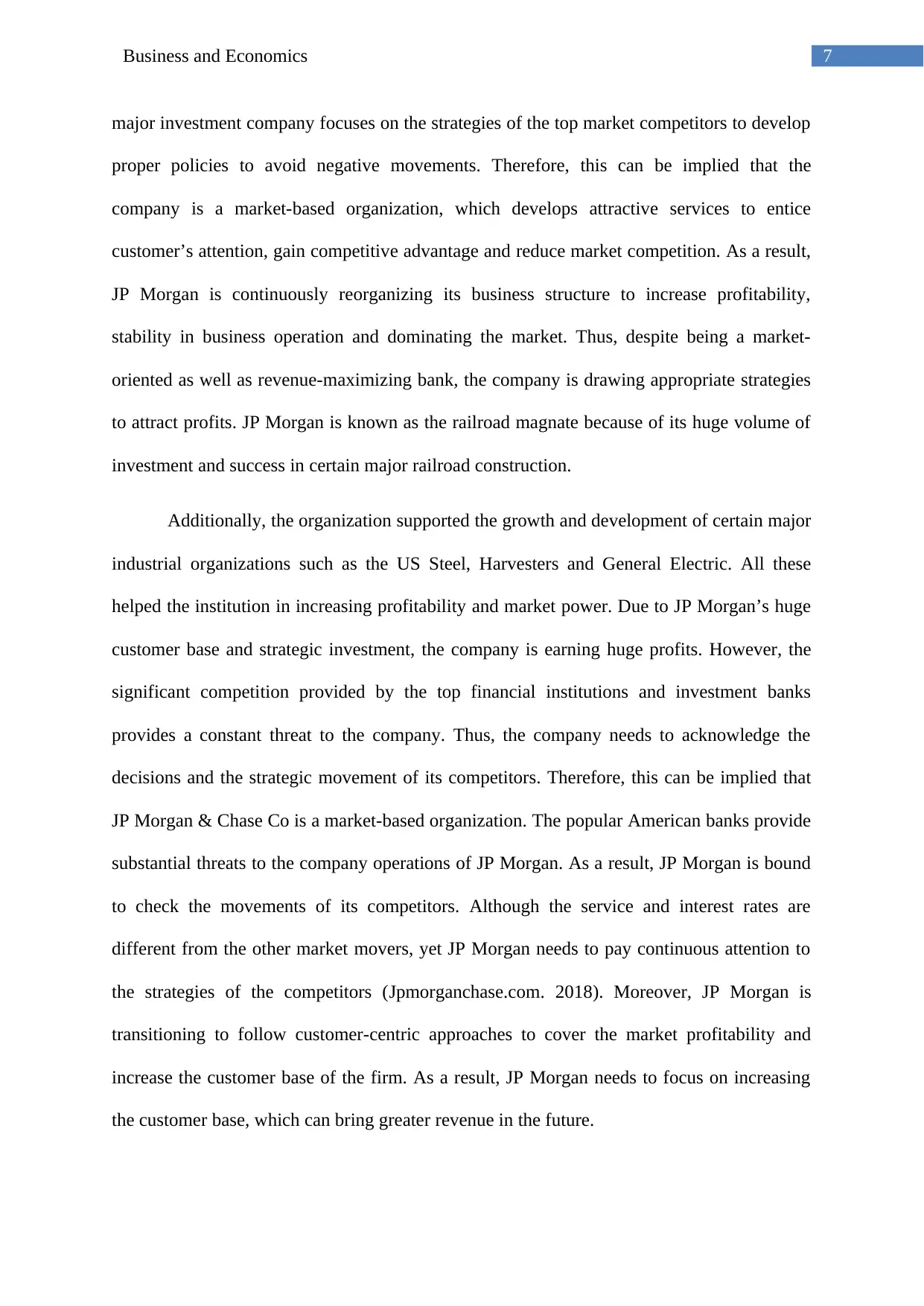
7Business and Economics
major investment company focuses on the strategies of the top market competitors to develop
proper policies to avoid negative movements. Therefore, this can be implied that the
company is a market-based organization, which develops attractive services to entice
customer’s attention, gain competitive advantage and reduce market competition. As a result,
JP Morgan is continuously reorganizing its business structure to increase profitability,
stability in business operation and dominating the market. Thus, despite being a market-
oriented as well as revenue-maximizing bank, the company is drawing appropriate strategies
to attract profits. JP Morgan is known as the railroad magnate because of its huge volume of
investment and success in certain major railroad construction.
Additionally, the organization supported the growth and development of certain major
industrial organizations such as the US Steel, Harvesters and General Electric. All these
helped the institution in increasing profitability and market power. Due to JP Morgan’s huge
customer base and strategic investment, the company is earning huge profits. However, the
significant competition provided by the top financial institutions and investment banks
provides a constant threat to the company. Thus, the company needs to acknowledge the
decisions and the strategic movement of its competitors. Therefore, this can be implied that
JP Morgan & Chase Co is a market-based organization. The popular American banks provide
substantial threats to the company operations of JP Morgan. As a result, JP Morgan is bound
to check the movements of its competitors. Although the service and interest rates are
different from the other market movers, yet JP Morgan needs to pay continuous attention to
the strategies of the competitors (Jpmorganchase.com. 2018). Moreover, JP Morgan is
transitioning to follow customer-centric approaches to cover the market profitability and
increase the customer base of the firm. As a result, JP Morgan needs to focus on increasing
the customer base, which can bring greater revenue in the future.
major investment company focuses on the strategies of the top market competitors to develop
proper policies to avoid negative movements. Therefore, this can be implied that the
company is a market-based organization, which develops attractive services to entice
customer’s attention, gain competitive advantage and reduce market competition. As a result,
JP Morgan is continuously reorganizing its business structure to increase profitability,
stability in business operation and dominating the market. Thus, despite being a market-
oriented as well as revenue-maximizing bank, the company is drawing appropriate strategies
to attract profits. JP Morgan is known as the railroad magnate because of its huge volume of
investment and success in certain major railroad construction.
Additionally, the organization supported the growth and development of certain major
industrial organizations such as the US Steel, Harvesters and General Electric. All these
helped the institution in increasing profitability and market power. Due to JP Morgan’s huge
customer base and strategic investment, the company is earning huge profits. However, the
significant competition provided by the top financial institutions and investment banks
provides a constant threat to the company. Thus, the company needs to acknowledge the
decisions and the strategic movement of its competitors. Therefore, this can be implied that
JP Morgan & Chase Co is a market-based organization. The popular American banks provide
substantial threats to the company operations of JP Morgan. As a result, JP Morgan is bound
to check the movements of its competitors. Although the service and interest rates are
different from the other market movers, yet JP Morgan needs to pay continuous attention to
the strategies of the competitors (Jpmorganchase.com. 2018). Moreover, JP Morgan is
transitioning to follow customer-centric approaches to cover the market profitability and
increase the customer base of the firm. As a result, JP Morgan needs to focus on increasing
the customer base, which can bring greater revenue in the future.
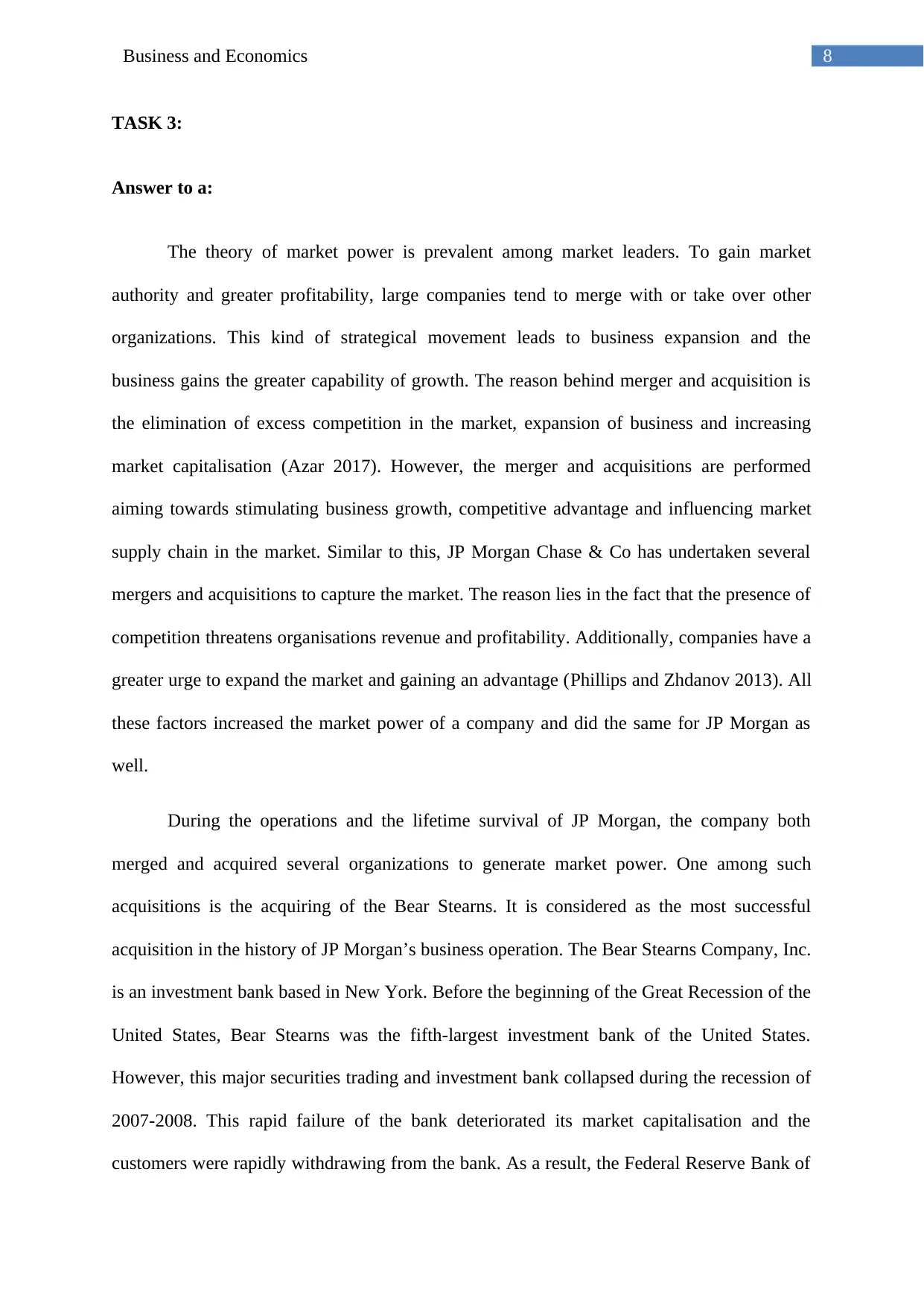
8Business and Economics
TASK 3:
Answer to a:
The theory of market power is prevalent among market leaders. To gain market
authority and greater profitability, large companies tend to merge with or take over other
organizations. This kind of strategical movement leads to business expansion and the
business gains the greater capability of growth. The reason behind merger and acquisition is
the elimination of excess competition in the market, expansion of business and increasing
market capitalisation (Azar 2017). However, the merger and acquisitions are performed
aiming towards stimulating business growth, competitive advantage and influencing market
supply chain in the market. Similar to this, JP Morgan Chase & Co has undertaken several
mergers and acquisitions to capture the market. The reason lies in the fact that the presence of
competition threatens organisations revenue and profitability. Additionally, companies have a
greater urge to expand the market and gaining an advantage (Phillips and Zhdanov 2013). All
these factors increased the market power of a company and did the same for JP Morgan as
well.
During the operations and the lifetime survival of JP Morgan, the company both
merged and acquired several organizations to generate market power. One among such
acquisitions is the acquiring of the Bear Stearns. It is considered as the most successful
acquisition in the history of JP Morgan’s business operation. The Bear Stearns Company, Inc.
is an investment bank based in New York. Before the beginning of the Great Recession of the
United States, Bear Stearns was the fifth-largest investment bank of the United States.
However, this major securities trading and investment bank collapsed during the recession of
2007-2008. This rapid failure of the bank deteriorated its market capitalisation and the
customers were rapidly withdrawing from the bank. As a result, the Federal Reserve Bank of
TASK 3:
Answer to a:
The theory of market power is prevalent among market leaders. To gain market
authority and greater profitability, large companies tend to merge with or take over other
organizations. This kind of strategical movement leads to business expansion and the
business gains the greater capability of growth. The reason behind merger and acquisition is
the elimination of excess competition in the market, expansion of business and increasing
market capitalisation (Azar 2017). However, the merger and acquisitions are performed
aiming towards stimulating business growth, competitive advantage and influencing market
supply chain in the market. Similar to this, JP Morgan Chase & Co has undertaken several
mergers and acquisitions to capture the market. The reason lies in the fact that the presence of
competition threatens organisations revenue and profitability. Additionally, companies have a
greater urge to expand the market and gaining an advantage (Phillips and Zhdanov 2013). All
these factors increased the market power of a company and did the same for JP Morgan as
well.
During the operations and the lifetime survival of JP Morgan, the company both
merged and acquired several organizations to generate market power. One among such
acquisitions is the acquiring of the Bear Stearns. It is considered as the most successful
acquisition in the history of JP Morgan’s business operation. The Bear Stearns Company, Inc.
is an investment bank based in New York. Before the beginning of the Great Recession of the
United States, Bear Stearns was the fifth-largest investment bank of the United States.
However, this major securities trading and investment bank collapsed during the recession of
2007-2008. This rapid failure of the bank deteriorated its market capitalisation and the
customers were rapidly withdrawing from the bank. As a result, the Federal Reserve Bank of
⊘ This is a preview!⊘
Do you want full access?
Subscribe today to unlock all pages.

Trusted by 1+ million students worldwide
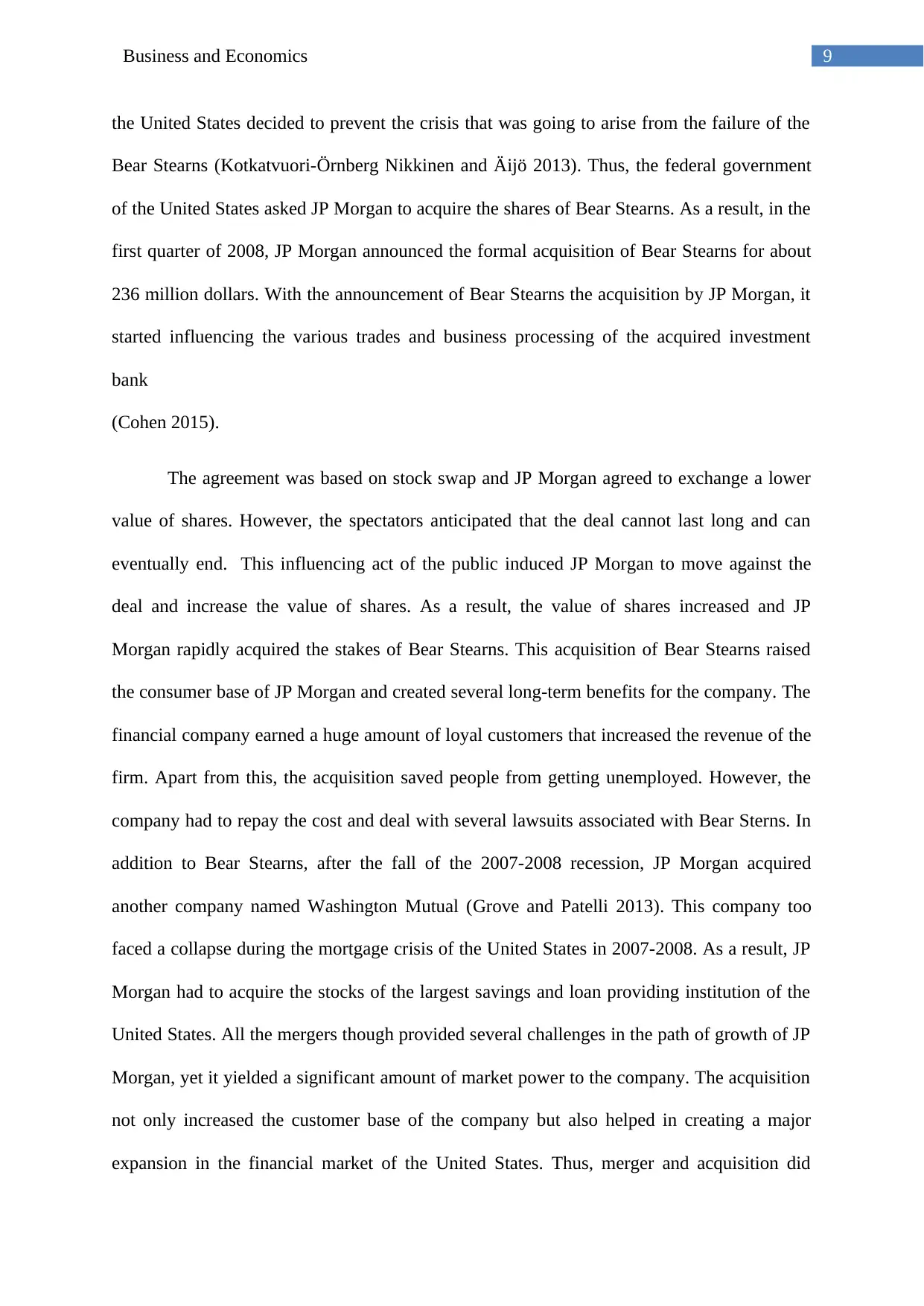
9Business and Economics
the United States decided to prevent the crisis that was going to arise from the failure of the
Bear Stearns (Kotkatvuori-Örnberg Nikkinen and Äijö 2013). Thus, the federal government
of the United States asked JP Morgan to acquire the shares of Bear Stearns. As a result, in the
first quarter of 2008, JP Morgan announced the formal acquisition of Bear Stearns for about
236 million dollars. With the announcement of Bear Stearns the acquisition by JP Morgan, it
started influencing the various trades and business processing of the acquired investment
bank
(Cohen 2015).
The agreement was based on stock swap and JP Morgan agreed to exchange a lower
value of shares. However, the spectators anticipated that the deal cannot last long and can
eventually end. This influencing act of the public induced JP Morgan to move against the
deal and increase the value of shares. As a result, the value of shares increased and JP
Morgan rapidly acquired the stakes of Bear Stearns. This acquisition of Bear Stearns raised
the consumer base of JP Morgan and created several long-term benefits for the company. The
financial company earned a huge amount of loyal customers that increased the revenue of the
firm. Apart from this, the acquisition saved people from getting unemployed. However, the
company had to repay the cost and deal with several lawsuits associated with Bear Sterns. In
addition to Bear Stearns, after the fall of the 2007-2008 recession, JP Morgan acquired
another company named Washington Mutual (Grove and Patelli 2013). This company too
faced a collapse during the mortgage crisis of the United States in 2007-2008. As a result, JP
Morgan had to acquire the stocks of the largest savings and loan providing institution of the
United States. All the mergers though provided several challenges in the path of growth of JP
Morgan, yet it yielded a significant amount of market power to the company. The acquisition
not only increased the customer base of the company but also helped in creating a major
expansion in the financial market of the United States. Thus, merger and acquisition did
the United States decided to prevent the crisis that was going to arise from the failure of the
Bear Stearns (Kotkatvuori-Örnberg Nikkinen and Äijö 2013). Thus, the federal government
of the United States asked JP Morgan to acquire the shares of Bear Stearns. As a result, in the
first quarter of 2008, JP Morgan announced the formal acquisition of Bear Stearns for about
236 million dollars. With the announcement of Bear Stearns the acquisition by JP Morgan, it
started influencing the various trades and business processing of the acquired investment
bank
(Cohen 2015).
The agreement was based on stock swap and JP Morgan agreed to exchange a lower
value of shares. However, the spectators anticipated that the deal cannot last long and can
eventually end. This influencing act of the public induced JP Morgan to move against the
deal and increase the value of shares. As a result, the value of shares increased and JP
Morgan rapidly acquired the stakes of Bear Stearns. This acquisition of Bear Stearns raised
the consumer base of JP Morgan and created several long-term benefits for the company. The
financial company earned a huge amount of loyal customers that increased the revenue of the
firm. Apart from this, the acquisition saved people from getting unemployed. However, the
company had to repay the cost and deal with several lawsuits associated with Bear Sterns. In
addition to Bear Stearns, after the fall of the 2007-2008 recession, JP Morgan acquired
another company named Washington Mutual (Grove and Patelli 2013). This company too
faced a collapse during the mortgage crisis of the United States in 2007-2008. As a result, JP
Morgan had to acquire the stocks of the largest savings and loan providing institution of the
United States. All the mergers though provided several challenges in the path of growth of JP
Morgan, yet it yielded a significant amount of market power to the company. The acquisition
not only increased the customer base of the company but also helped in creating a major
expansion in the financial market of the United States. Thus, merger and acquisition did
Paraphrase This Document
Need a fresh take? Get an instant paraphrase of this document with our AI Paraphraser
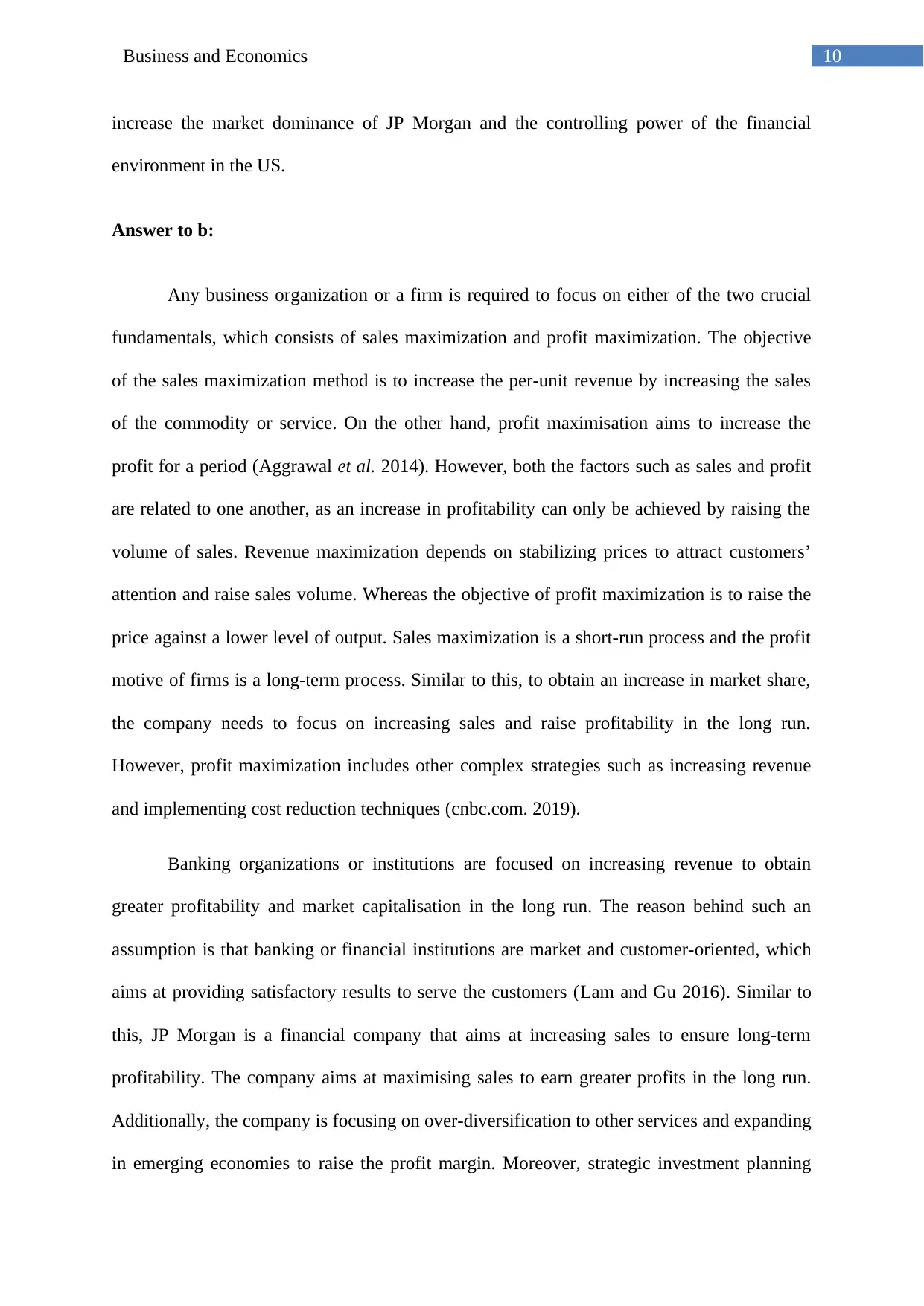
10Business and Economics
increase the market dominance of JP Morgan and the controlling power of the financial
environment in the US.
Answer to b:
Any business organization or a firm is required to focus on either of the two crucial
fundamentals, which consists of sales maximization and profit maximization. The objective
of the sales maximization method is to increase the per-unit revenue by increasing the sales
of the commodity or service. On the other hand, profit maximisation aims to increase the
profit for a period (Aggrawal et al. 2014). However, both the factors such as sales and profit
are related to one another, as an increase in profitability can only be achieved by raising the
volume of sales. Revenue maximization depends on stabilizing prices to attract customers’
attention and raise sales volume. Whereas the objective of profit maximization is to raise the
price against a lower level of output. Sales maximization is a short-run process and the profit
motive of firms is a long-term process. Similar to this, to obtain an increase in market share,
the company needs to focus on increasing sales and raise profitability in the long run.
However, profit maximization includes other complex strategies such as increasing revenue
and implementing cost reduction techniques (cnbc.com. 2019).
Banking organizations or institutions are focused on increasing revenue to obtain
greater profitability and market capitalisation in the long run. The reason behind such an
assumption is that banking or financial institutions are market and customer-oriented, which
aims at providing satisfactory results to serve the customers (Lam and Gu 2016). Similar to
this, JP Morgan is a financial company that aims at increasing sales to ensure long-term
profitability. The company aims at maximising sales to earn greater profits in the long run.
Additionally, the company is focusing on over-diversification to other services and expanding
in emerging economies to raise the profit margin. Moreover, strategic investment planning
increase the market dominance of JP Morgan and the controlling power of the financial
environment in the US.
Answer to b:
Any business organization or a firm is required to focus on either of the two crucial
fundamentals, which consists of sales maximization and profit maximization. The objective
of the sales maximization method is to increase the per-unit revenue by increasing the sales
of the commodity or service. On the other hand, profit maximisation aims to increase the
profit for a period (Aggrawal et al. 2014). However, both the factors such as sales and profit
are related to one another, as an increase in profitability can only be achieved by raising the
volume of sales. Revenue maximization depends on stabilizing prices to attract customers’
attention and raise sales volume. Whereas the objective of profit maximization is to raise the
price against a lower level of output. Sales maximization is a short-run process and the profit
motive of firms is a long-term process. Similar to this, to obtain an increase in market share,
the company needs to focus on increasing sales and raise profitability in the long run.
However, profit maximization includes other complex strategies such as increasing revenue
and implementing cost reduction techniques (cnbc.com. 2019).
Banking organizations or institutions are focused on increasing revenue to obtain
greater profitability and market capitalisation in the long run. The reason behind such an
assumption is that banking or financial institutions are market and customer-oriented, which
aims at providing satisfactory results to serve the customers (Lam and Gu 2016). Similar to
this, JP Morgan is a financial company that aims at increasing sales to ensure long-term
profitability. The company aims at maximising sales to earn greater profits in the long run.
Additionally, the company is focusing on over-diversification to other services and expanding
in emerging economies to raise the profit margin. Moreover, strategic investment planning
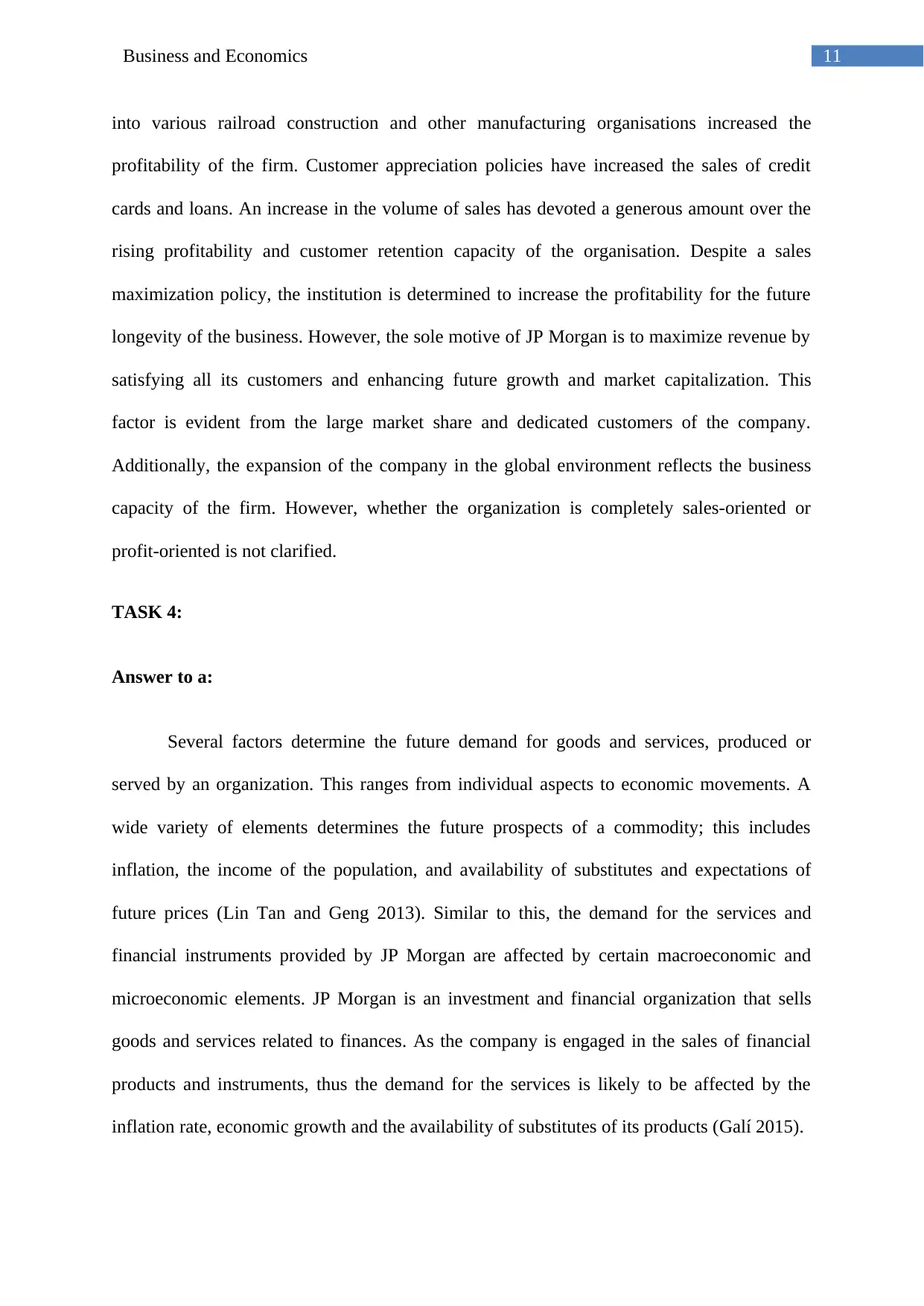
11Business and Economics
into various railroad construction and other manufacturing organisations increased the
profitability of the firm. Customer appreciation policies have increased the sales of credit
cards and loans. An increase in the volume of sales has devoted a generous amount over the
rising profitability and customer retention capacity of the organisation. Despite a sales
maximization policy, the institution is determined to increase the profitability for the future
longevity of the business. However, the sole motive of JP Morgan is to maximize revenue by
satisfying all its customers and enhancing future growth and market capitalization. This
factor is evident from the large market share and dedicated customers of the company.
Additionally, the expansion of the company in the global environment reflects the business
capacity of the firm. However, whether the organization is completely sales-oriented or
profit-oriented is not clarified.
TASK 4:
Answer to a:
Several factors determine the future demand for goods and services, produced or
served by an organization. This ranges from individual aspects to economic movements. A
wide variety of elements determines the future prospects of a commodity; this includes
inflation, the income of the population, and availability of substitutes and expectations of
future prices (Lin Tan and Geng 2013). Similar to this, the demand for the services and
financial instruments provided by JP Morgan are affected by certain macroeconomic and
microeconomic elements. JP Morgan is an investment and financial organization that sells
goods and services related to finances. As the company is engaged in the sales of financial
products and instruments, thus the demand for the services is likely to be affected by the
inflation rate, economic growth and the availability of substitutes of its products (Galí 2015).
into various railroad construction and other manufacturing organisations increased the
profitability of the firm. Customer appreciation policies have increased the sales of credit
cards and loans. An increase in the volume of sales has devoted a generous amount over the
rising profitability and customer retention capacity of the organisation. Despite a sales
maximization policy, the institution is determined to increase the profitability for the future
longevity of the business. However, the sole motive of JP Morgan is to maximize revenue by
satisfying all its customers and enhancing future growth and market capitalization. This
factor is evident from the large market share and dedicated customers of the company.
Additionally, the expansion of the company in the global environment reflects the business
capacity of the firm. However, whether the organization is completely sales-oriented or
profit-oriented is not clarified.
TASK 4:
Answer to a:
Several factors determine the future demand for goods and services, produced or
served by an organization. This ranges from individual aspects to economic movements. A
wide variety of elements determines the future prospects of a commodity; this includes
inflation, the income of the population, and availability of substitutes and expectations of
future prices (Lin Tan and Geng 2013). Similar to this, the demand for the services and
financial instruments provided by JP Morgan are affected by certain macroeconomic and
microeconomic elements. JP Morgan is an investment and financial organization that sells
goods and services related to finances. As the company is engaged in the sales of financial
products and instruments, thus the demand for the services is likely to be affected by the
inflation rate, economic growth and the availability of substitutes of its products (Galí 2015).
⊘ This is a preview!⊘
Do you want full access?
Subscribe today to unlock all pages.

Trusted by 1+ million students worldwide
1 out of 19
Related Documents
Your All-in-One AI-Powered Toolkit for Academic Success.
+13062052269
info@desklib.com
Available 24*7 on WhatsApp / Email
![[object Object]](/_next/static/media/star-bottom.7253800d.svg)
Unlock your academic potential
Copyright © 2020–2025 A2Z Services. All Rights Reserved. Developed and managed by ZUCOL.





